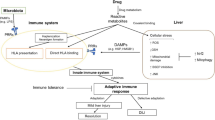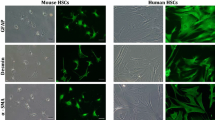Abstract
Extensive and persistent hepatic fibrosis has for a long time been considered irreversible. Accumulating evidence suggests that liver fibrosis is reversible and that recovery from cirrhosis may be possible. The application of molecular techniques to models of reversible fibrosis are helping to establish the events and processes that are critical to recovery. The problem consists in identifying and eliminating its cause. Although fibrosis in the liver has little functional significance by itself, its severity derives from associated vascular changes. Disappearance of fibrosis can be accompanied by remodeling of vascular changes. However, depending on its duration, the fibrosis may be irreversible.
Similar content being viewed by others
References
Benyon RC, Arthur MJ. Mechanisms of hepatic fibrosis. J Pediatr Gastroenterol Nutr 1998; 27: 75–85.
Rojkind M, Giambrone M-A, Biempica L. Collagen types in normal and cirrhotic liver. Gastroenterology 1979; 76: 710–719.
Seyer JM, Huherson ET, Kang AH. Collagen polymorphism in normal and cirrhotic human liver. J Clin Invest 1977; 59: 241–248.
McGuire RF, Bissell DM, Boyles J, Roll FJ. Role of extracellular matrix in regulating fenestrations of sinusoidal endothelial cells isolated from normal rat liver. Hepatology 1992; 15: 989–997.
Friedman SL. Molecular regulation of hepatic fibrosis, an integrated cellular response to tissue injury. J Biol Chem 2000; 275: 2247–2250.
Whalen R, Rockey DC, Friedman SL, Boyer TD. Activation of rat hepatic stellate cells leads to loss of glutathione S-transferases and their enzymatic activity against products of oxidative stress. Hepatology 1999; 30: 927–933.
Rockey DC. Hepatic blood flow regulation by stellate cells in normal and injured liver. Semin Liver Dis 2001; 21: 337–350.
Benyon D, Arthur MJP. Extracellular matrix degradation and the role of stellate cells. Semin Liver Dis 2001; 21: 373–384.
Friedmann SL, Bansal MB. Reversal of Hepatic Fibrosis — Fact or Fantasy? HEPATOLOGY 2006; 43: S82–S88.
Perez-Tamayo R. Degradation of collagen: pathology. In: Weiss JB, Jayson MIV, eds. Collagen in Health and Disease. London; Churchill Livingstone, 1982; 135–159.
Katz N, Brener Z. Evolução clínica de 112 casos de esquistossomose mansoni observados após dez anos de permanência em focos endêmicos de Minas Gerais. Revista do Instituto de Medicina Tropic de São Paulo 1966; 8: 139–142.
Bina JC, Prata A. Regressão da hepatoesplenomegalia pelo tratamento específico da esquistossomose. Revista da Sociedade Brasileira de Medicina Tropical 1983; 16: 213–218.
Homeida MA, Ahmed S, Dafalla A, Sulliman S, Eltom I, Nash T, Bennett JL. Morbidity associated with Schistosoma mansoni infection as determined by ultrasound: a study in Gezira, Sudan. Amer J Tropic Med and Hygiene 1988; 39: 196–201.
Mohamed-Ali Q, Doehring-Schwerdtfeger E, Abdel-Rahim IM, Schlake J, Kardoff R, Franke D, Kaiser C, Elsheikh M, Abdalla S, Schafer P, Ehrich JHH. Ultrasonographic investigation of periportal fibrosis in children with Schistosoma mansoni infection: reversibility of morbidity seven months after treatment with praziquantel. Amer J Tropic Med and Hygiene 1991; 44: 444–451.
Richter J. The impact of chemotherapy on morbidity due to Schistosomiasis. Acta Tropica 2003; 86: 161–183.
Dietze RS, Prata A. Rate of reversion of hepatosplenic schistosomiasis after specific chemotherapy. Revista da Sociedade Brasileira de Medicina Tropic 1986; 19: 69–73.
Andrade ZA, Peixoto E, Guerret S, Grimaud JA. Hepatic connective tissue changes in hepatosplenic schistosomiasis. Human Pathology 1992;23: 566–573.
Cameron CR, Ganguly NC. An experimental study of the pathogenesis and reversibility of schistosomal hepatic fibrosis. J Pathol and Bacteriol 1964; 87: 217–237.
Warren KS. The influence of treatment on the development and course of murine hepatosplenic schistosomiasis mansoni. Transact Royal Society of Tropic Med and Hygiene 1962; 56: 510–519.
Andrade ZA. Evolution and Involution of Hepatosplenic Schistosomiasis. Memórias do Instituto Oswaldo Cruz 1989; 84(suppl I): 58–75.
Andrade ZA, Grimaud JA. Evolution of schistosomal hepatic lesions in mice after curative chemotherapy. Amer J Pathology 1986; 124: 59–65.
Ferreira LA, Andrade ZA. Capillaria hepatica: a cause of septal fibrosis of the liver. Memórias do Instituto Oswaldo Cruz 1993; 88: 441–447.
Lemos QT, Magalhães Santos IF, Andrade ZA. Immunological basis of septal fibrosis of the liver in Capillaria hepatica-infected rats. Brazilian J Medic and Biology Research 2003; 36: 1201–1207.
Friedman SL. Mechanisms of hepatic fibrosis and therapeutic implications. Nature Clin Pract Gastroenterol Hepatol 2004; 1: 98–105.
Arthur MJP. Matrix degradation in liver: A role in injury and repair. Hepatology 1997; 26: 1069–1071.
Okazaki I, Maruyama K. Collagenase activity in experimental hepatic fibrosis. Nature 1974; 252: 49–50.
Maruyama K, Feinman L, Fainsilber Z et al. Mammalian collagenase increases in early alcoholic liver disease and decreases with cirrhosis. Life Sci 1982; 30: 1379–1384.
Knittel T, Mehde M, Kobold D et al. Expression patterns of matrix metalloproteinases and their inhibitors in parenchymal and non-parenchymal cells of rat liver: regulation by TNF-alpha and TGF-beta1. J Hepatol 1999; 30: 48–60.
Lichtinghagen R, Breitenstein K, Arndt B et al. Comparison of matrix metalloproteinase expression in normal and cirrhotic human liver. Virchows Arch 1998; 432: 153–158.
Kossakowska AE, Edwards DR, Lee SS et al. Altered balance between matrix metalloproteinases and their inhibitors in experimental biliary fibrosis. Am J Pathol 1998; 153: 1895–1902.
Matrisian LM. The matrix-degrading metalloproteinases. Bioessays 1992; 14: 455–463.
Knittel T, Fellmer P, Ramadori G. Gene expression and regulation of plasminogen activator inhibitor type I in hepatic stellate cells of rat liver. Gastroenterology 1996; 111: 745–754.
Ricard BS, Bresson HS, Guerret S et al. Mechanism of collagen network stabilization in human irreversible granulomatous liver fibrosis. Gastroenterology 1996; 111: 172–182.
Vater CA, Harris-ED J, Siegel RC. Native cross-links in collagen fibrils induce resistance to human synovial collagenase. Biochem J 1979; 181: 639–645.
Frisch SM, Francis H. Disruption of epithelial cell-matrix interactions induces apoptosis. J Cell Biol 1994; 124: 619–626.
Friedman SL, Roll FJ, Boyles J et al. Maintenance of differentiated phenotype of cultured rat hepatic lipocytes by basement membrane matrix. J Biol Chem 1989; 264: 10756–10762.
Iimuro Y, Nishio T, Morimoto T, Nitta T, Stefanovic B, Choi SK et al. Delivery of matrix metalloproteinase-1 attenuates established liver fibrosis in the rat. Gastroenterology 2003; 124: 445–458.
Dufour JF, DeLellis R, Kaplan MM. Regression of hepatic fibrosis in hepatitis C with long-term interferon treatment. Dig Dis Sci 1998; 43: 2573–2576.
Dufour JF, DeLellis R, Kaplan MM. Reversibility of hepatic fibrosis in autoimmune hepatitis. Ann Intern Med 1997; 127: 981–985.
Arthur MJP. Reversibility of liver fibrosis and cirrhosis following treatment for hepatitis C (Editorial). Gastroenterology 2002; 122: 1525–1528.
Villeneuve JP, Condreay LD, Willems B, Pomier-Layrargues G, Fenyves D, Bilodeau M, Leduc R et al. Lamivudine treatment for decompensated cirrhosis resulting from chronic hepatitis B. HEPATOLOGY 2000; 31: 207–210.
Popper H. Pathologic aspects of cirrhosis. A Review. Amer J Pathology 1977; 87: 227–264.
Desmet VJ, Roskams T. Cirrhosis reversal: a duel between dogma and myth. J Hepatology 2004;40: 860–867.
Friedman SL. Liver Fibrosis — From bench to bedside. J Hepatology 2003;38: 38–53.
Iredale JP, Benyon RC, Pickering J, McCullen M, Northrop M, Pawley S, Hovell C, Arthur MJP. Mechanisms of spontaneous resolution of rat liver fibrosis: hepatic stellate cell apoptosis and reduced hepatic expression of metalloproteinase inhibitors. J Clinic Investigation 1998; 102: 538–549.
Wanless IR, Nakashima E, Sherman M. Regression of human cirrhosis. Morphologic features and the genesis of incomplete septal cirrhosis. Arch Pathology and Lab Med 2000; 124: 1599–1607.
Quinn OS, Higginson J. Reversible and irreversible changes in experimental cirrhosis. Ameri J Pathology 1965; 47: 353–369.
Iwamoto H, Sakai H, Tada S et al. Induction of apoptosis in rat hepatic stellate cells by disruption of integrin-mediated cell adhesion. J Lab Clin Med 1999; 134: 83–89.
Di Vinicius I, Baptista AP, Barbosa Jr AA, Andrade ZA. Morphological signs of cirrhosis regression. (Experimental observations on carbon-tetrachloride-induced liver cirrhosis in rats). Pathol, Research and Practice 2005; 201(6): 449–456.
Author information
Authors and Affiliations
Corresponding author
Rights and permissions
About this article
Cite this article
Kumar, M., Sarin, S.K. Is cirrhosis of the liver reversible?. Indian J Pediatr 74, 393–399 (2007). https://doi.org/10.1007/s12098-007-0067-1
Received:
Accepted:
Published:
Issue Date:
DOI: https://doi.org/10.1007/s12098-007-0067-1




